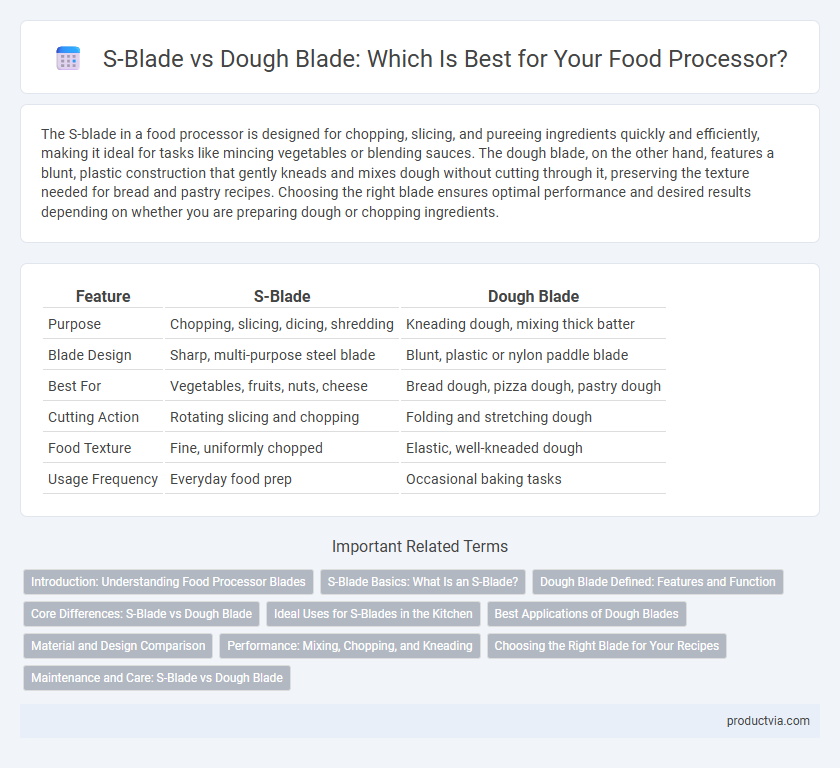The S-blade in a food processor is designed for chopping, slicing, and pureeing ingredients quickly and efficiently, making it ideal for tasks like mincing vegetables or blending sauces. The dough blade, on the other hand, features a blunt, plastic construction that gently kneads and mixes dough without cutting through it, preserving the texture needed for bread and pastry recipes. Choosing the right blade ensures optimal performance and desired results depending on whether you are preparing dough or chopping ingredients.
Table of Comparison
| Feature | S-Blade | Dough Blade |
|---|---|---|
| Purpose | Chopping, slicing, dicing, shredding | Kneading dough, mixing thick batter |
| Blade Design | Sharp, multi-purpose steel blade | Blunt, plastic or nylon paddle blade |
| Best For | Vegetables, fruits, nuts, cheese | Bread dough, pizza dough, pastry dough |
| Cutting Action | Rotating slicing and chopping | Folding and stretching dough |
| Food Texture | Fine, uniformly chopped | Elastic, well-kneaded dough |
| Usage Frequency | Everyday food prep | Occasional baking tasks |
Introduction: Understanding Food Processor Blades
S-blades and dough blades serve distinct functions in a food processor, with the S-blade designed for chopping, slicing, and pureeing ingredients, while the dough blade is specialized for kneading and mixing dough. The S-blade's sharp, stainless steel design efficiently handles vegetables, nuts, and meats, making it versatile for everyday food preparation. In contrast, the dough blade, often made of plastic or a less sharp material, mimics hand-kneading to develop gluten in dough without cutting through it, ensuring proper texture for bread and pastries.
S-Blade Basics: What Is an S-Blade?
The S-blade in a food processor is a versatile, dual-edged blade designed for chopping, slicing, and blending a variety of ingredients with precision and speed. Made typically from stainless steel, it features a sharp, curved shape that efficiently cuts through vegetables, nuts, and soft fruits, making it essential for recipes requiring finely processed textures. Unlike the dough blade, which is specialized for mixing and kneading dough with its blunt, plastic construction, the S-blade excels in tasks requiring fine, uniform cuts and purees.
Dough Blade Defined: Features and Function
The dough blade of a food processor features a blunt, plastic design specifically made for kneading and mixing heavy, dense doughs without cutting through the ingredients. Unlike the sharp S-blade, which excels at chopping, slicing, and pureeing, the dough blade gently folds and combines dough components to develop gluten structure efficiently. This specialized blade ensures proper consistency and texture when preparing bread, pizza, or pastry dough, preventing overworking and overheating of the mixture.
Core Differences: S-Blade vs Dough Blade
The S-blade in a food processor is designed primarily for chopping, slicing, and pureeing ingredients with sharp, multi-purpose stainless steel blades that handle vegetables, nuts, and fruits efficiently. In contrast, the dough blade features a blunt, plastic, or metal design specifically engineered for kneading dough without cutting or shredding, preserving the dough's texture. Choosing between the S-blade and dough blade depends on whether the task requires precise chopping or gentle mixing for bread, pizza, or pastry dough preparation.
Ideal Uses for S-Blades in the Kitchen
S-blades in food processors excel at chopping, slicing, and pureeing vegetables, fruits, and nuts with precision and speed. Their sharp, multi-purpose design makes them ideal for preparing ingredients for soups, sauces, and smoothies, ensuring consistent texture and finely processed results. These blades are perfect for everyday kitchen tasks that require efficient and uniform cutting, enhancing meal preparation versatility.
Best Applications of Dough Blades
Dough blades in food processors are specifically designed for kneading and mixing heavy, dense doughs such as bread, pizza, and pasta dough, offering superior handling without over-processing. Unlike S-blades that chop and puree, dough blades operate at slower speeds to develop gluten structure, resulting in better texture and elasticity. Using a dough blade ensures consistent dough preparation, saving time and effort compared to manual kneading.
Material and Design Comparison
S-blades are typically crafted from high-quality stainless steel, designed with sharp, multi-level serrated edges for efficient chopping, slicing, and blending of various ingredients. Dough blades, made from durable plastic or reinforced nylon, feature a blunt, wider design optimized for gentle mixing and kneading of dough without cutting. The material resilience and blade shape directly influence performance, with stainless steel S-blades excelling in precision tasks and plastic dough blades preventing over-processing of delicate dough textures.
Performance: Mixing, Chopping, and Kneading
The S-blade excels in chopping and mixing tasks with sharp, multi-purpose edges designed for efficient processing of vegetables, nuts, and meats, delivering consistent, finely chopped results. The dough blade features a blunt, plastic design optimized for kneading heavy dough, providing gentle and thorough mixing without overworking the gluten structure. While the S-blade offers versatility in food preparation, the dough blade specializes in performance for bread and pastry doughs, ensuring optimal texture and elasticity.
Choosing the Right Blade for Your Recipes
Choosing the right blade for your food processor ensures optimal results for each recipe, with the S-blade excelling at chopping, slicing, and pureeing a variety of ingredients including vegetables, nuts, and fruits. The dough blade, often made of plastic with a blunt edge, is specifically designed for kneading dough, combining ingredients without cutting, which preserves the texture and elasticity needed for bread, pizza, or pastry dough. Understanding these distinctions allows home cooks to maximize efficiency and achieve the desired consistency in their culinary creations.
Maintenance and Care: S-Blade vs Dough Blade
The S-blade, made from stainless steel, requires regular cleaning to prevent food buildup and maintain sharpness, and it is generally dishwasher safe for easier maintenance. Dough blades, often made from plastic, need thorough washing and drying to avoid cracking or warping, as they are typically less durable than metal blades and often must be hand-washed. Proper storage and care, such as avoiding abrasive materials and ensuring blades are fully dry before storing, prolong the lifespan of both S-blades and dough blades in food processors.
S-blade vs Dough blade for food processor Infographic

 productvia.com
productvia.com